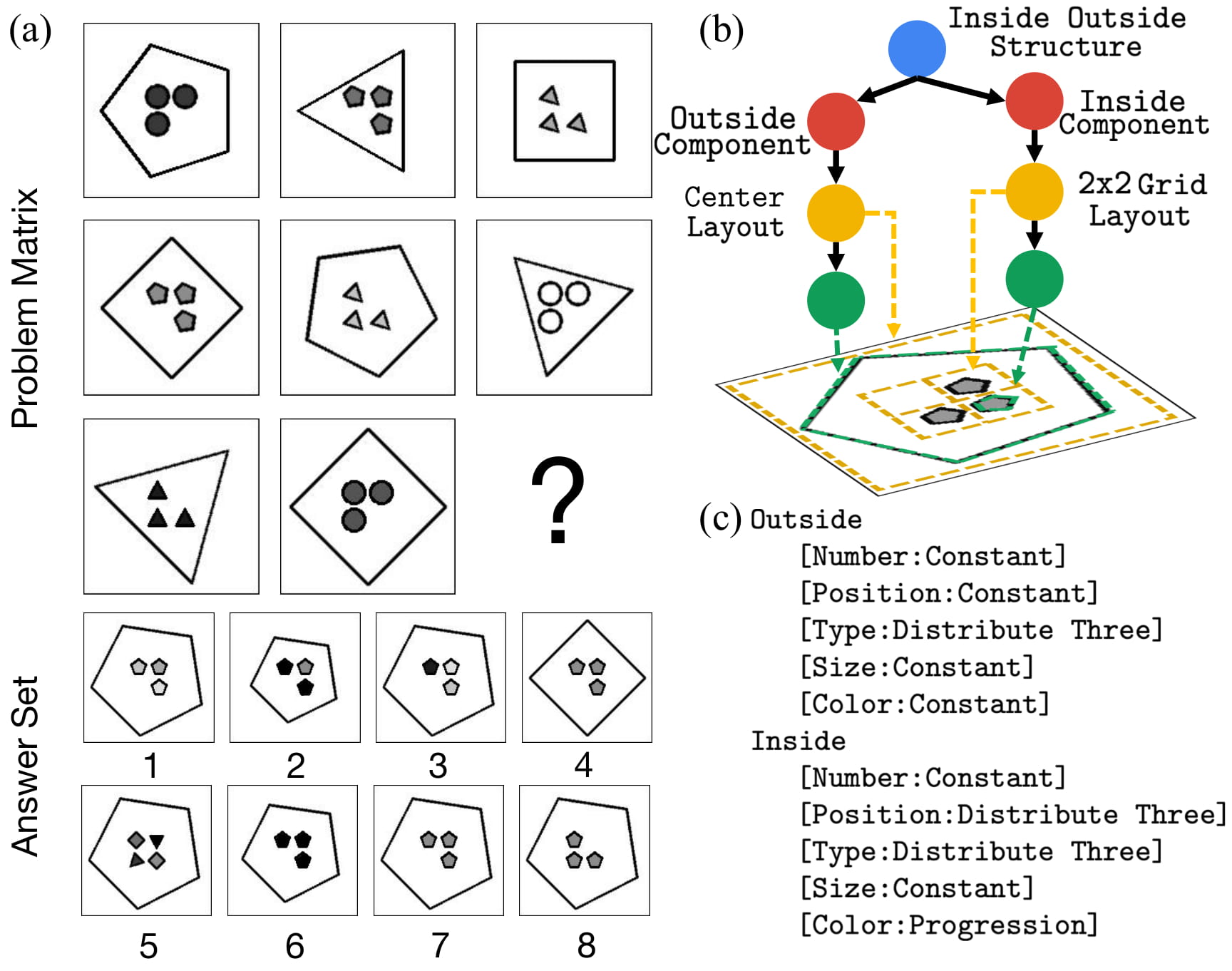RAVEN
This repo contains code for our CVPR 2019 paper.
RAVEN: A Dataset for Relational and Analogical Visual rEasoNing
Chi Zhang*, Feng Gao*, Baoxiong Jia, Yixin Zhu, Song-Chun Zhu
Proceedings of the IEEE Conference on Computer Vision and Pattern Recognition (CVPR), 2019
(* indicates equal contribution.)
Dramatic progress has been witnessed in basic vision tasks involving low-level perception, such as object recognition, detection, and tracking. Unfortunately, there is still an enormous performance gap between artificial vision systems and human intelligence in terms of higher-level vision problems, especially ones involving reasoning. Earlier attempts in equipping machines with high-level reasoning have hovered around Visual Question Answering (VQA), one typical task associating vision and language understanding. In this work, we propose a new dataset, built in the context of Raven's Progressive Matrices (RPM) and aimed at lifting machine intelligence by associating vision with structural, relational, and analogical reasoning in a hierarchical representation. Unlike previous works in measuring abstract reasoning using RPM, we establish a semantic link between vision and reasoning by providing structure representation. This addition enables a new type of abstract reasoning by jointly operating on the structure representation. Machine reasoning ability using modern computer vision is evaluated in this newly proposed dataset. Additionally, we also provide human performance as a reference. Finally, we show consistent improvement across all models by incorporating a simple neural module that combines visual understanding and structure reasoning.
Dataset
The dataset is generated using the attributed stochastic image grammar. An example is shown below.
The grammatical design makes the dataset flexible and extendable. In total, we come up with 7 different figural configurations.
The dataset formatting document is in assets/README.md. To download the dataset, please check our project page.
Performance
We show performance of models in the following table. For details, please check our paper.
| Method | Acc | Center | 2x2Grid | 3x3Grid | L-R | U-D | O-IC | O-IG |
|---|---|---|---|---|---|---|---|---|
| LSTM | 13.07% | 13.19% | 14.13% | 13.69% | 12.84% | 12.35% | 12.15% | 12.99% |
| WReN | 14.69% | 13.09% | 28.62% | 28.27% | 7.49% | 6.34% | 8.38% | 10.56% |
| CNN | 36.97% | 33.58% | 30.30% | 33.53% | 39.43% | 41.26% | 43.20% | 37.54% |
| ResNet | 53.43% | 52.82% | 41.86% | 44.29% | 58.77% | 60.16% | 63.19% | 53.12% |
| LSTM+DRT | 13.96% | 14.29% | 15.08% | 14.09% | 13.79% | 13.24% | 13.99% | 13.29% |
| WReN+DRT | 15.02% | 15.38% | 23.26% | 29.51% | 6.99% | 8.43% | 8.93% | 12.35% |
| CNN+DRT | 39.42% | 37.30% | 30.06% | 34.57% | 45.49% | 45.54% | 45.93% | 37.54% |
| ResNet+DRT | 59.56% | 58.08% | 46.53% | 50.40% | 65.82% | 67.11% | 69.09% | 60.11% |
| Human | 84.41% | 95.45% | 81.82% | 79.55% | 86.36% | 81.81% | 86.36% | 81.81% |
| Solver | 100% | 100% | 100% | 100% | 100% | 100% | 100% | 100% |
Dependencies
Important
- Python 2.7
- OpenCV
- PyTorch
- CUDA and cuDNN expected
See requirements.txt for a full list of packages required.
Usage
Dataset Generation
Code to generate the dataset resides in the src/dataset folder. To generate a dataset, run
python src/dataset/main.py --num-samples <number of samples per configuration> --save-dir <directory to save the dataset>
Check the main.py file for a full list of arguments you can adjust.
Benchmarking
Code to benchmark the dataset resides in src/model. To run the code, first put assets/embedding.npy in the dataset folder as specified in the src/model/utility/dataset_utility.py. Then run
python src/model/main.py --model <model name> --path <path to the dataset>
You can check the main.py file for a full list of arguments. This repo only supports Resnet18_MLP, CNN_MLP, and CNN_LSTM. For WReN, please check the implementation in the WReN repo.
Note that for batch processing, we implement the DRT as a maximum tree of all possible tree structures and prune the branches during training based on an indicator.
Citation
If you find the paper and/or the code helpful, please cite us.
@inproceedings{zhang2019raven,
title={RAVEN: A Dataset for Relational and Analogical Visual rEasoNing},
author={Zhang, Chi and Gao, Feng and Jia, Baoxiong and Zhu, Yixin and Zhu, Song-Chun},
booktitle={Proceedings of the IEEE Conference on Computer Vision and Pattern Recognition (CVPR)},
year={2019}
}
Acknowledgement
We'd like to express our gratitude towards all the colleagues and anonymous reviewers for helping us improve the paper. The project is impossible to finish without the following open-source implementation.


